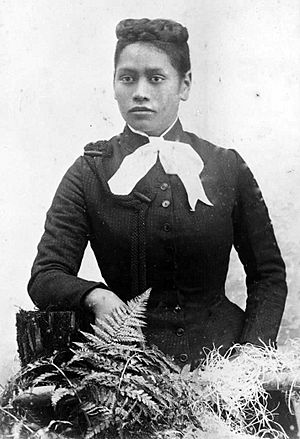Meri Mangakāhia facts for kids
Meri Te Tai Mangakāhia (born May 22, 1868 – died October 10, 1920) was a very important leader for women's rights in New Zealand. She worked hard to help women get the right to vote. Her actions inspired many Māori women who came after her.
Contents
The Life of Meri Mangakāhia
Early Life and Education
Meri Te Tai Mangakāhia was born on May 22, 1868. Her birthplace was Lower Waihou, near Panguru in the Hokianga valley. She belonged to the Te Rarawa iwi (tribe). Her family lines included Ngāti Te Rēinga, Ngāti Manawa, and Te Kaitutae. Meri's father, Re Te Tai, was a powerful chief.
Meri went to school at St Mary's Convent in Auckland. She was a very talented piano player.
A Voice for Women's Rights
Meri Mangakāhia was the third wife of Hāmiora Mangakāhia. He worked as a judge in the Native Land Court. In June 1892, Hāmiora was chosen to be the Premier of the Kotahitanga Parliament. This was a special Māori parliament in Hawke's Bay.
The next year, Meri made history. She spoke to the Kotahitanga Parliament. She was the first woman ever to do so. Meri asked that women be allowed to vote for members of the Parliament. She also wanted women to be able to become members themselves.
Meri was asked to come to the House to explain her idea. This made her the first woman to speak directly to the Kotahitanga Parliament.
Why Women Needed a Voice
Meri Mangakāhia explained her reasons clearly. She said that Māori women had always owned land in their traditions. But under the new laws from the British government (called the Crown), they were losing their land.
She felt that Māori men were not solving land problems fast enough. Meri believed that Queen Victoria might listen more to requests from other women. She pointed out that Māori women were landowners. Because of this, they should not be stopped from being part of political decisions.
Making a Difference
In 1893, Meri helped start Ngā Kōmiti Wāhine. These were committees for women that worked with the Kotahitanga Parliament.
Her hard work paid off. In 1897, women won the right to vote in the Kotahitanga elections. This was a big step forward for Māori women.
Meri continued to be involved in Māori politics and welfare. She joined the women's committee of the Kotahitanga movement. These committees were early versions of the Māori Women's Welfare League.
She also started a newspaper section called Te Reiri Karamu (The Ladies’ Column). She worked on this with Niniwa I te Rangi. This part of the newspaper was a place for Māori women to talk about their issues. They could share their ideas and debate important topics.
Later Life and Legacy
Meri Mangakāhia passed away on October 10, 1920. She died from influenza in Panguru. She was buried near her father at Pureirei cemetery in Lower Waihou.
Meri had four children. Her two sons were Mohi and Waipapa. Her two daughters were Whangapoua Tangiora Edith and Mabel Te Aowhaitini. Meri Te Tai Mangakāhia's work helped shape the future for Māori women.
See also
 In Spanish: Meri Te Tai Mangakahia para niños
In Spanish: Meri Te Tai Mangakahia para niños


